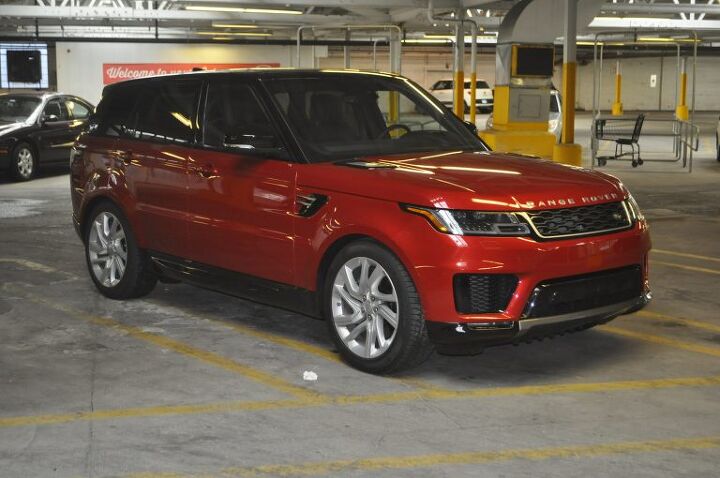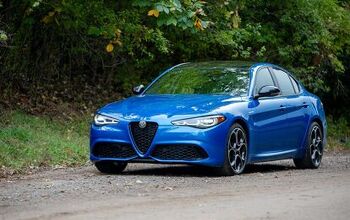2019 Range Rover Sport HSE P400e Review - Green Cred Will Cost You

2019 Land Rover Range Rover Sport HSE P400e Fast Facts
Even Range Rovers need to go green.
Or, at the very least, offer “green” engine options to accrue cred with the right kind of well-heeled buyers.
While I believe some of the greenies with plenty of green in their bank account are sincere about their intentions to save the planet (and I definitely believe the climate is changing, and we’re at fault), other green types are simply signaling virtue. Still others think they’re doing the right thing, without considering that not all hybrids are the same.
Some hybrids aren’t even meant to maximize fuel economy – their electrified hardware strives mainly for enhanced performance.
Enter the 2019 Land Rover Range Rover Sport HSE P400e (Land Rover insists on the “Land Rover Range Rover” naming convention, and now that we’ve got the SEO-friendly text out of the way, we’ll be dropping that). The performance numbers are solid. The MPGe number isn’t terrible. But 19 mpg in gas-only mode? That’s not great. The electric-only mileage range is up to 19 miles, and if the battery is drained, you’re likely to see numbers closer to that 19 mpg figure. Other reviewers who measure fuel economy certainly did.
The 2.0-liter turbocharged four-cylinder gas engine makes 296 horsepower, while the electric-motor it pairs with puts out 114 horsepower. Total system power is 398 horsepower and 472 lb-ft of torque. Yes, I know the hp numbers don’t add up correctly – that’s usually the case with hybrid systems.
All-wheel drive gets the power to optional 21-inch wheels via an eight-speed automatic transmission, and an electric air suspension with adaptive damping underpins it all. That all-wheel-drive system has an electronic differential that can torque vector via braking.
Land Rover/Range Rover would love to tell you all about the plug-in hybrid’s trickery and wizardry and how that makes this heavy SUV better at saving the planet than a similar-sized, petrol-only luxury barge, but while there is cool green tech on hand, that tech takes a backseat to performance when you’re behind the wheel.
[Get new and used Land Rover Range Rover Sport HSE P400e pricing here!]
About that wizardry: Here are a few examples of what Range Rover has cooked up. One neat trick is that if you’re using the nav system to guide you, it will take traffic, environment, and other factors into account to operate the hybrid system in the most efficient manner.
Trick number two: You get regen not just when braking, but also when coasting.
Trick number three: When in Sport mode, the system sends extra charge to the battery, so that the electric motor can be used to boost performance.
Trick number four: A Save mode holds battery charge so it can be used later.
Full EV mode can be activated via a button, if the driver so chooses.
All of this goes unnoticed, unless you’re paying close attention. Mostly, the Range Rover Sport P400e drives like any other Range Rover Sport – accelerates relatively quickly for a heavy luxo SUV, has steering that feels sporty enough, and rides like a luxury vehicle.
Inside, the P400e has the dual-screen center stack that a lot of JLR models are rocking these days, and it looks good and works well. Same goes for the capacitive-touch steering-wheel controls. The interior looks and feels as luxurious as you’d expect at this price point. That said, I cringe at the thought of any of those things needing repair once the warranty ends. That’s not a shot at JLR’s less-than-stellar reputation for reliability – well, not entirely – but even if the brand had a rep for being bulletproof, I’d still be concerned. Even the most reliable brands aren’t perfect.
Outside, you get the usual Rover box-it-came-in shape, with a sloping, angular nose giving the look a bit more aggression.
Standard features include blind-spot monitoring, traffic-sign recognition, adaptive speed limiter, driver-condition monitoring, rear-cross traffic monitoring, clear-exit monitoring, LED headlights and DRLs, power liftgate, panoramic sunroof, rain-sensing wipers, leather seats, heated front seats, dual-zone climate control, power tilt/telescope steering wheel, keyless entry and starting, premium audio, 10-inch touchscreen, navigation, satellite radio, USB, Bluetooth, ambient interior lights, Wi-Fi hotspot, and an interactive gauge display.
The options list is where things get insane, as they often do with high-dollar luxury imports. Let’s start with the $4,000 Driver Assist Pack, which includes blind-spot assist, 360-degree camera, adaptive cruise control with steering assist, high-speed emergency braking, lane-keep assist, and park assist. Similar features are available for less money, or even standard, on some mainstream vehicles.
A Climate Comfort Pack includes heated steering wheel, four-zone climate control, sliding panoramic roof, and a refrigerated compartment in the console for $1,385. The $1,635 Vision Assist Pack includes automatic high-beam assist, configuration options for the ambient interior lighting, and head-up display. Add $355 for headliner there, and $665 for a black roof here, and a pinch of $355 black veneer, plus a dash of $610 soft door-close, with another $710 for the red paint, and $100 for cabin air ionization, and 21-inch wheels at $1,835, plus $1,120 to heat AND cool the front (and rear) seats, and top it all off with a $135 110-volt socket, and you have a recipe for an SUV that crossed the $90K mark.
It’s one thing to be judicious with the option box. The real question is – does your lifestyle make sense for a PHEV that costs several grand more than gas-powered versions? Are the potential fuel savings worth it? Will you drive the vehicle in such a manner that you’ll actually save on petrol? That’s what one of the buff books asked – and I think that’s a very good question.
Of course, the math is just part of the equation. For some, it will be about the cool factor. Others will love to feel green even if they’re burning deceased dinosaurs most of the time.
You don’t need to sacrifice luxury or performance for this plug-in hybrid. But you will need to lay out extra cash up front.
Whether that’s worth it to you is your choice.
[Images © 2020 Tim Healey/TTAC]

Tim Healey grew up around the auto-parts business and has always had a love for cars — his parents joke his first word was “‘Vette”. Despite this, he wanted to pursue a career in sports writing but he ended up falling semi-accidentally into the automotive-journalism industry, first at Consumer Guide Automotive and later at Web2Carz.com. He also worked as an industry analyst at Mintel Group and freelanced for About.com, CarFax, Vehix.com, High Gear Media, Torque News, FutureCar.com, Cars.com, among others, and of course Vertical Scope sites such as AutoGuide.com, Off-Road.com, and HybridCars.com. He’s an urbanite and as such, doesn’t need a daily driver, but if he had one, it would be compact, sporty, and have a manual transmission.
More by Tim Healey
Latest Car Reviews
Read moreLatest Product Reviews
Read moreRecent Comments
- SilverHawk Growing up in California, I ran the Corkscrew in a number of different low power sports cars, but nothing really fast. I had a real blast doing it in a 66 Barracuda Formula S that I could barely handle through the curves. The car had more skill than I had. Quite an experience.
- Fred This is one car I never see anymore. Where did they all go?
- Daniel Bridger The increased cost of electricity is raging faster than the government's manipulation of ICE fuel.
- Zipper69 Why the choice of a four door shell.Packing this tech into Stinger would have been awesome.
- Eric I have no desire to have an EV. Too expensive, no charging facilities within 50 miles are even planned, unproven technology, arguably even more environmentally harmful than ICE vehicles. Besides being a status symbol and to signal virtue, what's to like?






































Comments
Join the conversation
19 miles is not to be sniffed at if that range works for a daily commute. If you the. Use these type of cars for a lot of weekend motorway driving it actually does make a lot of sense. So for some people this works well
Depreciation on these is horrifying, that's the worst part.